Introduction
Scientifically speaking, genetics plays a great role in determining the size of your calves. Despite knowing this, people (men especially) with small or normal-sized calves have not stopped trying to make theirs bigger. Some of these men even go as far as getting calf implants or doing more leg day workouts just to prep for shorts season. What’s all the calf craze about? Could there be benefits associated with having big calves? Do the cons of having wide calves outweigh the pros? Are there special compression socks for such calves? If there are, how do you choose the best for your calves?
Also, let’s talk about how to use compression socks as calf slimming socks …

Large Calves
Our calf is mainly made up of two large muscles, the soleus and the gastrocnemius. Along with some smaller muscles, these muscles work with the tibialis anterior to carry us wherever we go. So, when we’re talking about having big calves, it’s typically due to an increase in size of these two muscles.

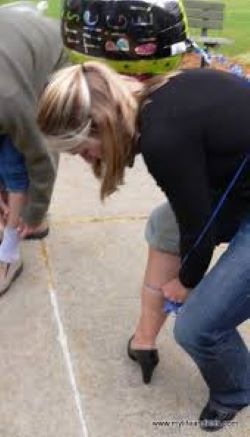
Large calves can be caused by the following:
Your anatomy or genetics
Your thick calves may be a result of your anatomy, which is linked to the size of your Achilles tendon. The Achilles tendon is the tendon that attaches the back of your heel to your calf muscle. People who are born with shorter Achilles tendons are more likely to have larger calf muscles. This is because the calf muscles have to extend to the lower part of your leg just to reach the tendon attachment.

If you are born with short Achilles tendons, there is nothing you can do about your large calves as it is impossible to lengthen the tendon. However, you can prevent your calves from getting larger by avoiding exercises, such as calf raises, that will make those muscles larger.
Your Activity
Repetitive activities that force you to use the balls of your feet can increase the size of your calves. These activities could be intense sports and workouts or everyday movements.
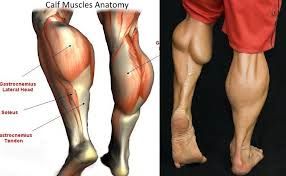
Also, walking in high heels or shoes that offer poor support could force you to walk on the balls of your feet and, therefore, build up your calf muscles.
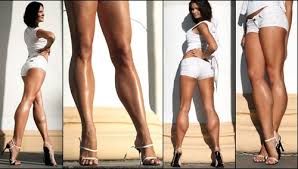
If you do not want your calf muscles to get bigger, you will have to change these lifestyle habits.
Fatty Tissues
Your body fat percentage may be an indicator of why your calves are larger than normal. Having too much fat in your calf region can make them bulge. Putting on weight is one of the easiest ways to get larger calves, however, it can impede blood flow in your calf area which may cause toxins to build up in your lower leg muscles. Wearing compression socks for larger calves can improve blood flow and microcirculation.
If you are not a fan of wide calves, you should maintain a healthy body weight by eating a well-balanced diet and getting regular exercise.
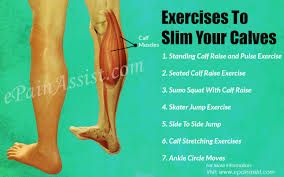
Edema
Edema is the collection of fluid in and around your muscle tissues. Otherwise known as ‘swelling’, edema can definitely make your calves larger. You can check for edema by pressing your finder into your calves. Edematous tissues will maintain a small pit where your finger pressed, while non-swollen tissue will bounce right back. Causes of edema include:
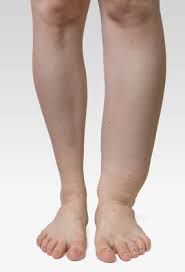
- Allergic reactions
- Birth control pills
- Drug abuse and alcohol
- Poor diet with excess carbohydrates
- Pregnancy
- Varicose and spider veins
All these causes require quick treatment as you risk having high blood pressure, heart problems, or headaches if left untreated. One of the best treatments for edema is wearing large calf compression socks.
Popular Articles on ComproGear
Best Compression Socks for Sitting All Day Compression Socks for Desk Job
Compression Socks for Ankle Swelling We Review The Best Swollen Ankle Socks
Compression Socks for Nurses Best Nurses Socks Review
Compression Socks for Swollen Feet Best Socks for Swollen Ankles and Legs
Wide Calf Compression Socks Women’s Mid Calf Compression Socks in 2XL, 3XL, 4XL, 5XL, and 6XL
Best Compression Socks for Elderly We Review Compression Socks for the Elderly
Super Plus Size Compression Stockings The Best Knee High Compression Socks in 2XL, 3XL, 4XL, 5XL, and 6XL
Facts Associated with Having Big Calves
Big calves are great, but they are a kind of mixed bag. Some of the facts associated with having big calves can be seen below:

Reduction in stroke risk: A study consisting of 6,265 people has found that the larger the calves, the smaller the risk of having a stroke. Irrespective of age, body mass index, gender, and some vascular risk factors, people with bigger calves have fewer fatty deposits, called plagues, that build up in their arteries. Therefore, they have lower risk of having stenosis, strokes, and carotid artery disease. This could be as a result of the fact that big calves give the body more space to store fat that may cause problems if it stays in the bloodstream.
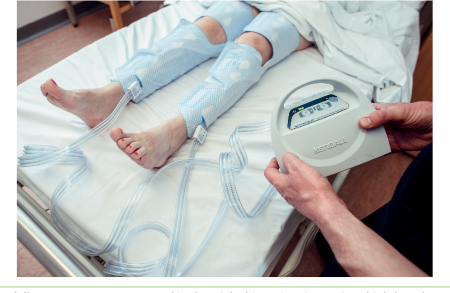
Calf muscles are associated with overall musculature: According to research, calf size indicates muscle mass throughout the body. People with a wider calf circumference have more skeletal muscle and appendicular muscle. And strong calves can help you to stand longer.

Larger calf muscles mean a lower resting heart rate: According to a study, the smaller the calves, the higher the resting heart rate, and vice versa. Having a resting heart rate of more than 100 beats per minute has been linked to increased risk of death irrespective of how fit you are physically. People with bulkier calves, like marathon runners and other athletes, naturally have lower resting heart rates.

Calf muscles tend to deflate over time: Many skeletal muscles of the body deflate with age, and the calf muscles are no exception. This process, which may begin around age 40, is known as sarcopenia. If noticed early enough, this muscle loss can be offset through regular exercise. Maintaining muscle mass in your senior years not only makes you look better, it also keeps you mobile and improves circulation.
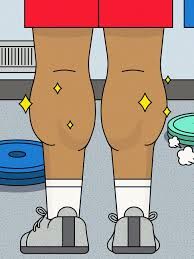
How to Get a Larger Calf
There is a calf craze that comes and goes with every season, especially among male athletes. Even Tiger Woods has been rumored to have serious hang-ups from time to time because of his skinny stems. If you think your calves are small and look too silly, there are ways you can grow them, even without focusing specifically on the calf muscles.
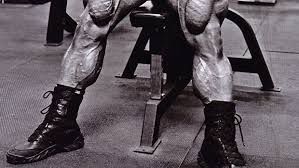
Here are some things you can do to get bigger calves:
- Single-leg hopping and jumping
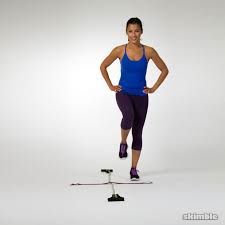
- Sprinting and exercises that involve changing directions
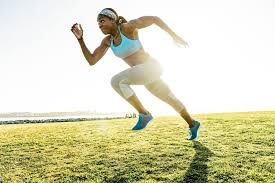
- Glute ham raises
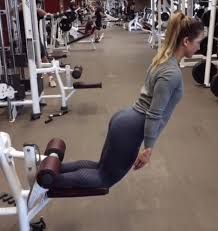
- Jump squats
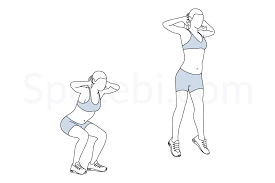
- Plyos
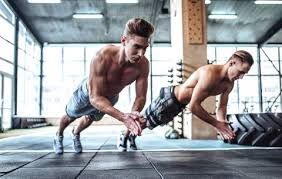
- Squats
- Eat healthy protein to gain more weight. Your calves will grow as well as the rest of your body.

- Jump rope

- Weighted-box jumps
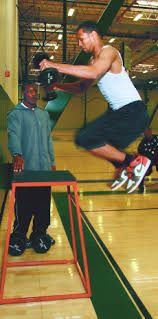
- Walk 20-30 minutes per day, 3-6 days per week wearing a weighted vest.

Large Calf Compression Socks
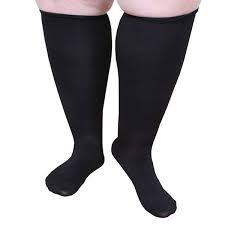
Compression Stockings for large calves are medical grade socks that should fit snugly.
Big calf compression socks are often sized this way:
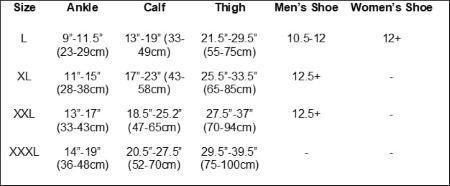
These socks come in different styles:
- Large calf compression socks for running
- Large calf compression socks for men
- Large calf compression socks for women
All the types of large calf compression socks vary in design, color and size. The large calf socks for nurses are clearly different from compression socks for runners. You have to know that these socks are mostly context dependent. Find the category you fall into and get the best in that category.
Choosing the Best Compression Gear for Wider Calves
Getting the best compression socks for large calves can be quite frustrating because they will often feel tight. First, you have to find a brand that makes high-quality extra wide calf compression socks.
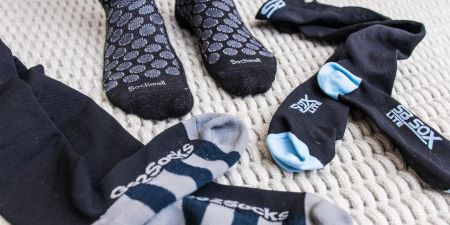
Graduated compression
There are two types of compression socks, graduated and uniform. Graduated models are the best for large calves as they will put more pressure on the ankles, but the pressure subsides a little as the socks go higher on the legs. The design of these socks helps to improve circulation without necessarily cutting off blood flow.
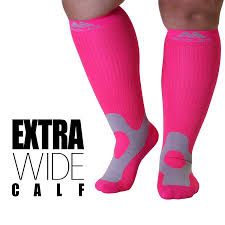
Depending on the cause of your large calves; the compression level, measured in mmHg, is the key to getting relief. How do you know the best strength of compression? The more severe your condition, the stronger the compression you will need. Below are the standard levels of compression to help guide you.
- 8-15 mmHg (Mild Compression):
Basically, this level of compression helps to relieve and minimize achy and tired legs. It also prevents leg fatigue due to extended periods of standing or sitting. Another benefit of using this mild compression is that it helps to provide relief from minor swelling of the foot, ankle, and leg. For pregnant women, it helps in preventing formation of varicose and spider veins. With this compression, you can maintain healthier and more energized legs.
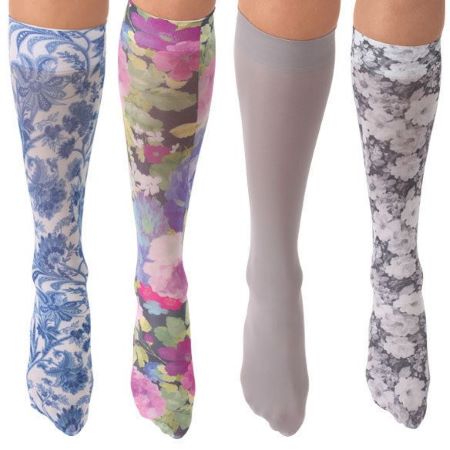
- 15-20 mmHg (Moderate compression):
With moderate compression levels, you can prevent and relieve cases of minor to moderate varicose and spider veins. You will also enjoy relief from aches and fatigue, as well as swelling of the foot, ankle, and leg. You can also use this to prevent deep vein thrombosis (DVT) or economy class syndrome. Moderate compression is used during post-sclerotherapy treatment to prevent varicose and spider veins from reappearing as well. This is the perfect compression level for people who are traveling long distances.
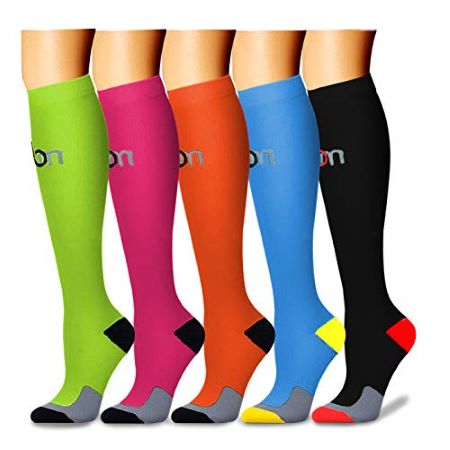
- 20-30 mmHg (Firm compression):
This level of compression helps to prevent and relieve superficial thrombophlebitis, orthostatic hypotension, deep vein thrombosis (DVT), and moderate to severe varicose veins (even during pregnancy). It is also used for post-sclerotherapy and post-surgical treatment to help prevent the reappearance of these issues. It can help in treating moderate to severe edema. With firm compression, active ulcers and symptoms of post-thrombotic syndrome can be better managed.
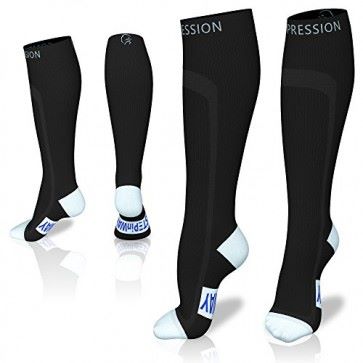
- 30-40 mmHg (Extra Firm Compression):
Extra firm compression is used in treating severe edema and lymphedema. It also helps to prevent and relieve severe varicose veins as well as deep vein thrombosis (DVT). It can be used to manage venous ulcers and manifestations of Post-Thrombotic Syndrome (PTS). Symptoms of orthostatic hypotension and postural hypotension can be reduced as well. It is also used in post-surgical and post-sclerotherapy treatment to help in preventing the reappearance of varicose and spider veins.

50-60 mmHg (Heavy Compression):
This is the strongest level of compression. It is used in cases of severe post thrombotic syndrome and primary lymphedema.

Size
Another thing to consider when choosing compression socks for large calves is the size. Compression socks that are too small will be very uncomfortable to wear. On the other hand, socks that are too big will not exert the right level of compression and may slip off. Make sure you choose the right size for your calf. Measuring can be done by a certified fitter or by yourself at home. Here is a comprehensive sizing guide to help you:
Knee-high compression socks sizing guide for men and women
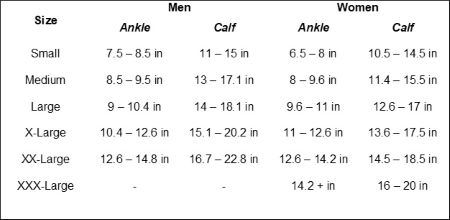
Thigh-high compression socks sizing guide for men and women
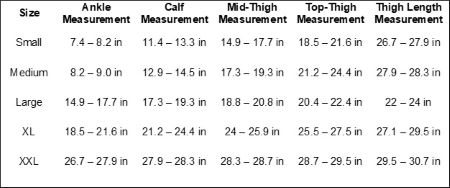
Calf sleeves sizing guide in Centimeters
| Size | Calf Size |
| Small | 29 – 36 cm |
| Medium | 33 – 40 cm |
| Large | 37 – 44 cm |
| X-Large | 41 – 47 cm |
Ankle sizing guide for men and women
| Size | Calf Size |
| Regular | 2 – 6 |
| Large | 7 – 11 |
| X-Large | 12 – 15 |
Material
When it comes to large calf compression socks, it all comes down to stretch. The material has to be stretchable, and is often made of a blend of nylon and spandex. To enjoy the full effect of the compression technology, the socks should be firm and hold your skin quite tightly.
Seamless design
Breathability
With compression socks for large calves, your skin has to breathe whether you are walking, running, or cycling. It is unhygienic and uncomfortable to have sweat soaking your socks. Some socks come with yarns of copper containing antibacterial properties to further enhance the hygiene.
Things to Do Before Putting On Your Socks for Bigger Calves
After buying the best large calf compression socks, the next step is to put them on. Before doing so, here are some things to consider:
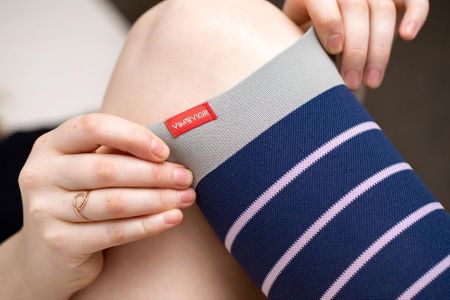
- As soon as you buy your new compression stockings for large calves, it is recommended that you hand wash them. This will help to make them more flexible so you can wear them more easily. If you can afford to, buy a second pair so you will have a clean pair to use when the other is being washed.
- If you have an open wound on your legs, put a dressing on it before putting on your compression socks.
- Your compression socks should always be by your bed. This will make them easily accessible for you to put on as soon as you get out of bed.
How to Put On Your Socks

Since your legs should have little or no swelling while you are still in bed, you should put on your compression socks first thing in the morning. Here are the simple steps to take in wearing your large calf compression socks:
- Sit in a chair that has a back so you can have something to lean against when putting on your compression socks.

- Hold onto the top of your sock, and roll it down till you get to the heel.
- Place your foot inside the sock. Push it in as far as you can. Try to place your heel inside the heel of the sock.
- Pull up the sock, then unroll the sock up your leg. Pull until the sock gets to its full length. For instance, knee length socks should get to 2 fingers below your knee bend.
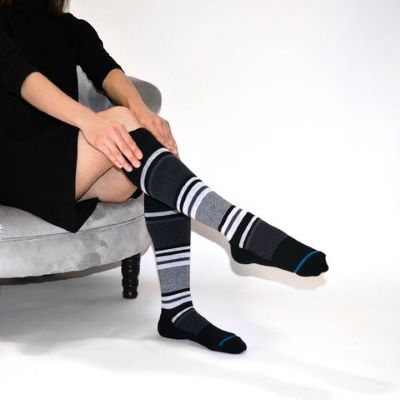
- Try not to grab your sock and pull at its top, because doing so can make it rip or tear.
- When the sock is in place, smooth out wrinkles or folds.
- Check to make sure your compression sock does not bunch up or wrinkle on your leg.
Having Trouble Wearing Your Compression Socks?
Sometimes, wearing your compression socks with your large calves can be difficult. In some cases, the difficulty may be from the compression socks brand and not the size of your legs. When this happens, you can try the following tips:
- Wear rubber dishwashing gloves so you can get a firmer grip on the fabric. Wearing gloves also makes it easier for you to adjust and smooth out the compression socks.

- Apply silicon lotion (like ALPS) on your legs, up to your knee. Allow it to dry before putting on your compression socks. If your socks contain latex, or you are not sure whether or not they do, do not use other creams or lotions on your legs when wearing the socks.
- Apply a little cornstarch or baby powder on your legs to make the compression socks slide up easily.
- If you bought toeless compression socks, you can try using a silk slip sock. It helps you slide the sock over your foot, and pulls the sock off through the toe when you want to remove it.
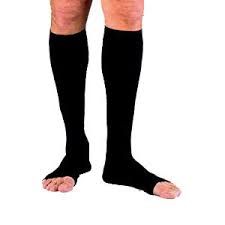
- Use a stocking aid or stocking donner to slide the compression socks over your foot. However, before buying one, make sure you try it on first because some of them are hard to use.
- If you have a disability that makes it hard for you to put on compression socks, you should consult your doctor or a certified fitter at the medical supply store.
- Call your doctor if you notice discoloration, pain, or numbness on your toes when wearing the compression socks.
Conclusion
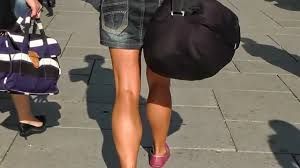
As with human anatomy, some people have larger calves than others. ComproGear can provide you with the best socks for large calves so you feel comfortable irrespective of the size of your legs.
This page last updated November 4, 2022
